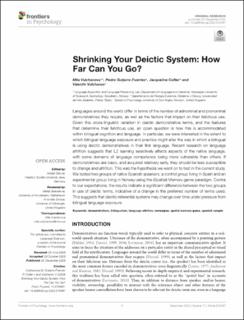| dc.contributor.author | Vulchanova, Mila Dimitrova | |
| dc.contributor.author | Guijarro-Fuentes, Pedro | |
| dc.contributor.author | Collier, Jacqueline | |
| dc.contributor.author | Vulchanov, Valentin | |
| dc.date.accessioned | 2022-05-04T10:03:40Z | |
| dc.date.available | 2022-05-04T10:03:40Z | |
| dc.date.created | 2020-10-24T16:56:05Z | |
| dc.date.issued | 2020 | |
| dc.identifier.issn | 1664-1078 | |
| dc.identifier.uri | https://hdl.handle.net/11250/2994099 | |
| dc.description.abstract | Languages around the world differ in terms of the number of adnominal and pronominal demonstratives they require, as well as the factors that impact on their felicitous use. Given this cross-linguistic variation in deictic demonstrative terms, and the features that determine their felicitous use, an open question is how this is accommodated within bilingual cognition and language. In particular, we were interested in the extent to which bilingual language exposure and practice might alter the way in which a bilingual is using deictic demonstratives in their first language. Recent research on language attrition suggests that L2 learning selectively affects aspects of the native language, with some domains of language competence being more vulnerable than others. If demonstratives are basic, and acquired relatively early, they should be less susceptible to change and attrition. This was the hypothesis we went on to test in the current study. We tested two groups of native Spanish speakers, a control group living in Spain and an experimental group living in Norway using the (Spatial) Memory game paradigm. Contra to our expectations, the results indicate a significant difference between the two groups in use of deictic terms, indicative of a change in the preferred number of terms used. This suggests that deictic referential systems may change over time under pressure from bilingual language exposure. | en_US |
| dc.language.iso | eng | en_US |
| dc.publisher | Frontiers | en_US |
| dc.relation.uri | https://doi.org/10.3389/fpsyg.2020.575497 | |
| dc.rights | Navngivelse 4.0 Internasjonal | * |
| dc.rights.uri | http://creativecommons.org/licenses/by/4.0/deed.no | * |
| dc.title | Shrinking your deictic system: How far can you go? | en_US |
| dc.title.alternative | Shrinking your deictic system: How far can you go? | en_US |
| dc.type | Peer reviewed | en_US |
| dc.type | Journal article | en_US |
| dc.description.version | publishedVersion | en_US |
| dc.source.journal | Frontiers in Psychology | en_US |
| dc.identifier.doi | 10.3389/fpsyg.2020.575497 | |
| dc.identifier.cristin | 1841943 | |
| dc.relation.project | EC/H2020/676063 | en_US |
| cristin.ispublished | true | |
| cristin.fulltext | original | |
| cristin.qualitycode | 1 | |

